
Last June, during the International Polar Year conference, James Overland suggested that there are more cold and snowy winters to come. He argued that the exceptionally cold snowy 2009-2010 winter in Europe had a connection with the loss of sea-ice in the Arctic. The cold winters were associated with a persistent ‘blocking event’, bringing in cold air over Europe from the north and the east.
Last year’s cold winter over northern Europe was also associated with an extreme situation associated with the North Atlantic Oscillation (NAO), with the second lowest value for the NAO-index on record (see figure below).
I admit, last winter felt quite cold, but still it wasn’t so cold when put into longer historical perspective. This is because I remember the most recent winters more vividly than those of my childhood – which would be considered to be really frosty by today’s standards. But such recollections can be very subjective, and more objective measurements show that the winters in Europe have in general become warmer in the long run, as explained in the German blog called ‘Wissenlogs’. If there were no trend, then such a low NAO-index as last year’s would normally be associated with even colder conditions over Europe than those observed during the previous winter.
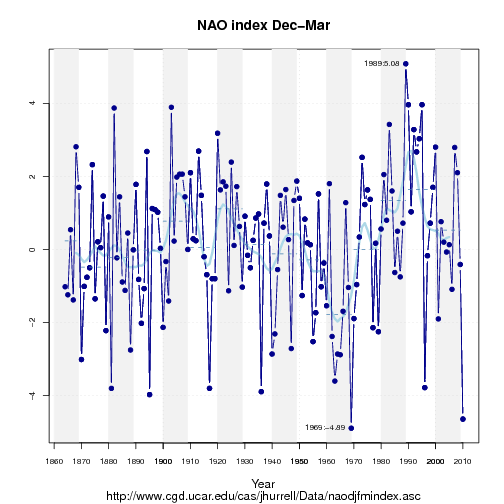
In a more recent press-release, Vladimir Petoukhov and Vladimir Semenov, argue that Global Warming could cool down winter temperatures over Europe, and a reduced sea-ice extent could increase the chance of getting cold winters. Also they propose that cold winters are associated with the atmospheric circulation (see schematic below), and their press-release was based on a paper in Journal of Geophysical Research (JGR), which may seem to have a serendipitous timing with the cold spell over Europe during the last weeks. However, the original manuscript was submitted in november 2009 (before the statement made by James Overland) and accepted in May 2010. One could regard the paper more as a ‘prediction’ rather than an ‘explanation’.
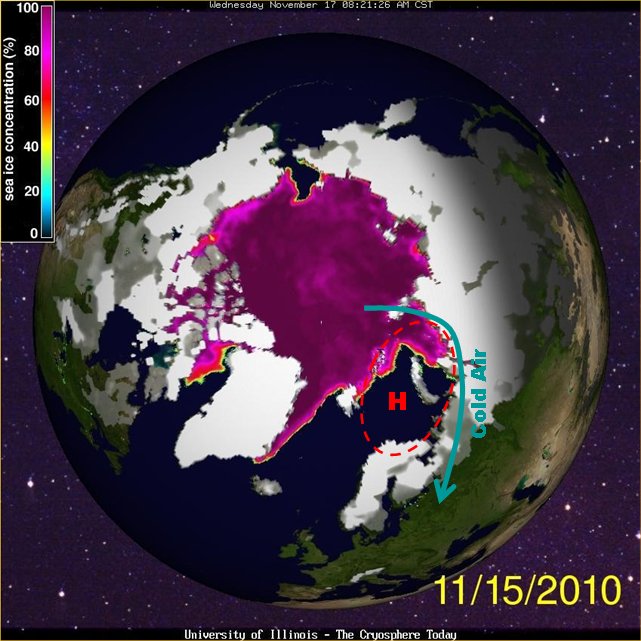
Although Petoukhov and Semenov’s findings sound plausible, I don’t think they are as straight-forward as they initially seem in terms of their implications for this winter either. For one thing, it is impossible to prove that one single event is due to a change in the long-term, as we pointed out for the case of hurricanes (The 2010 hurricane season this year, by the way, was quite active).
I think it is important to keep in mind that the Petoukhov and Semenov study is based on a global atmosphere model that simulated a non-linear response to the loss of sea-ice in the Barents-Kara seas: initially warm winters, followed by cold, and then warm winters, as the sea-ice extent is gradually reduced.
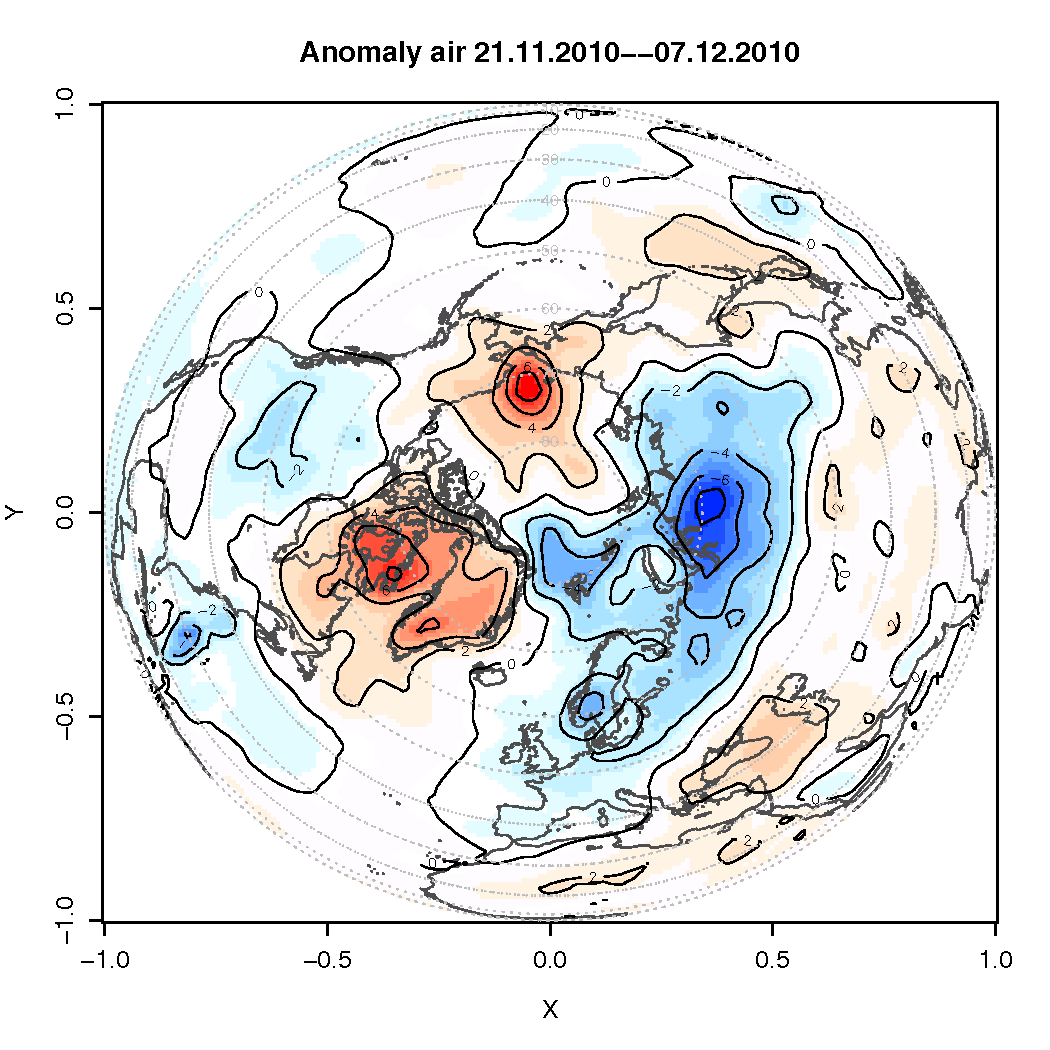
One interesting question is how the Barents-Kara sea-ice affects the winter temperatures over the northern continents. By removing the sea-ice, the atmosphere above feels a stronger heating from the ocean, resulting in anomalous warm conditions over the Barent-Kara seas. The local warming gives rise to altered temperature profiles (temperature gradients) along the vertical and horizontal dimensions.
Changes in the temperature profiles, in turn, affect the circulation, triggering a development of a local blocking structure when the sea-ice extent is reduced from 80% to 40%. But Petoukhov and Semenov also found that it brings a different response when the sea-ice is reduced from 100% to 80% or from 40% to1%, and hence a non-linear response. The most intriguing side to this study was the changing character of the atmospheric response to the sea-ice reduction: from a local cyclonic to anti-cyclonic, and back to cyclonic pattern again. These cyclonic and anti-cyclonic patterns bear some resemblance to the positive and negative NAO phases.
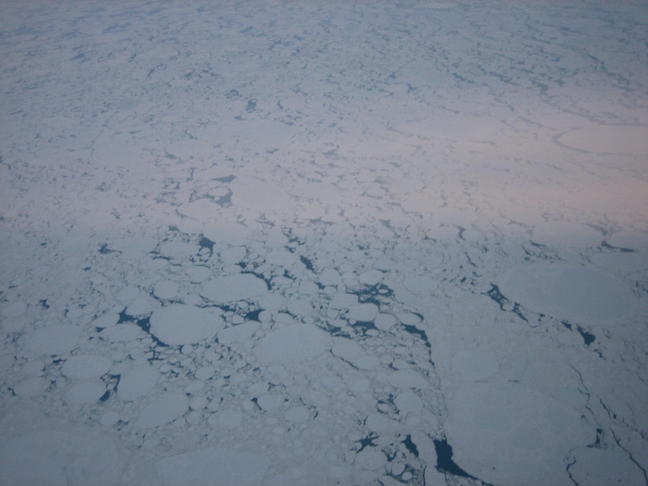
They also show a different response in surface air temperature (SAT) during December, January, and February. From their Figure 2, it is not immediately obvious from that figure that a sea-ice reduction leads to lower SAT during January. This is, however, very much in line with similar analysis that I have carried out with colleagues and struggled to find a consistent response (albeit we looked at the summer season).
But Petoukhov and Semenov provide theoretical support for their observations, and argue that the non-linear response can be explained in terms of ‘convectional-frictional’ and ‘baro-clinic-frictional’ mechanisms. The former includes warming over the areas where sea-ice disappear, and changes in the vertical temperature gradients, stability, and hence friction, while the latter involves a change in the surface friction force associated with temperature changes over distances.
I think that the scientific community will need some time to confirm this link, and there are some
important caveats: For one thing, the spatial model resolution (the size between the boxes in the grid mesh, through which the models represent the world) has an influence on their ability to represent blocking frequency. Hazeleger et al. Has observed that “… different horizontal resolutions … confirm the resolution-dependence found in NWP [Numerical Weather Prediction]”. The atmospheric model used by Petoukhov and Semenov has a fairly coarse spatial resolution (2.8 degrees x2.8 degrees), and it is legitimate to question whether it can reproduce the
frequencies of blocking events realistically, and whether that has a bearing for the conclusions.
But also the fact that the sea-surface temperatures (SSTs) were fixed in these experiments may affect the conclusions. Balmaseda et al. found that the atmospheric response to changes in sea-ice conditions may depend on the background SSTs, at least for the summer months. They also compared results from a coupled ocean-atmosphere model with the results from an atmosphere model for which the SSTs were given. Their unexpected finding was that the atmospheric response in these two cases were very different.
In fact, global atmospheric and climate models are better at describing the large picture than more regional and local characteristics. There is a limit to what they are able to describe in terms of local regional details, and it it reasonable to ask whether the response to changes in regional sea-ice cover is beyond the limitation of the global model. If different models give different answers, then it is likely that the response is not robust.
Another interesting question is whether the sea-ice the is whole story. Not long ago, there were some suggestions of a link between low solar activity and cold winters (this correlation, however, is so weak that you would never notice without statistical analysis. Also see comment here). Do these factors affect the circulation patterns over the North Atlantic? The sunspots tend to vary on a time scale of 10-12 years, but the NAO-index suggests that few of the extreme low values were repeated over two subsequent years. In other words, the NAO doesn’t show the same persistence as the sunspots. It will be interesting to see if this winter will break with previous patterns – if it does, that could be interpreted as a support of Petoukhov and Semenov hypothesis.
It is nevertheless no contradiction between a global warming and cold winters in regions like Europe. Rather, recent analysis suggest that the global mean temperature is marching towards higher values (see figure below), and Petoukhov and Semenov argue that the cold winter should be an expected consequence of a global warming.
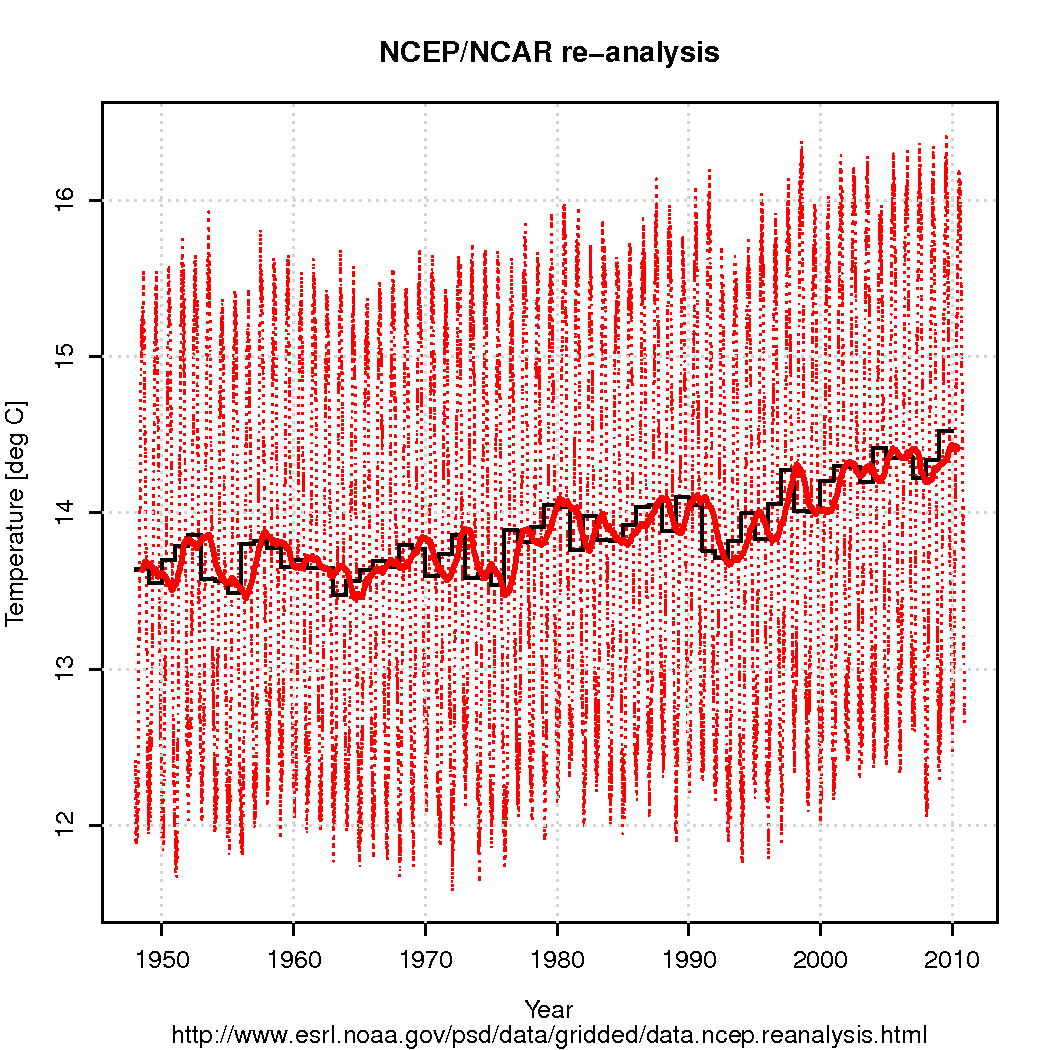
Aaron Lewis #338, where did you in 2003 make your predictions that you say our host “shouted down” as alarmism? Just curious.
Yes, I do think the human contribution (although technically, it IS from the dinosaurs) is more important. Of *course* it is. If the increase was natural, it’s highly unlikely that it would be so fast, and it’s the speed of the increase as much as the quantity that’s important.
The rise is *thousands* of times faster than it would likely be if it were natural. And, it’s now at a level higher than any our species has seen. Ever.
Gaya, I don’t think you have any basis for claiming that the human contribution is more important. Dinosaurs were much larger than humans and the methane from their waste could easily have caused a much faster rate of change in the atmosphere. Nobody can prove that human contribution is faster than natural forcings because they base it off of nothing. What is our contribution measured against? Nothing. I don’t see any difference between driving a car and a horse taking a dump on the side of the road. Again, you have no basis for claiming the rise in co2 is thousands of times faster than it otherwise would be. Actually, the earth must’ve had much faster rising co2 levels because atmospheric content has been much higher. I am sad to see history began when you were born, Gaya.
[Response: It might be more useful if you actually gave sources and data and reasoned arguments for your point of view, rather than simply repeating your opinion. Arguing for the sake of it is simply noise. PS. I rather doubt that dinosaurs tripled their population and created an industrial economy based on fossil fuels in under a century. They may have been big, but I think we likely had the edge on them in turns of rapidity of growth. – gavin]
Well Gavin I’m glad to see this response. I don’t have research to prove that dinosaurs caused a more rapid atmospheric change than humans but I don’t think you have research to the contrary either.
[Response: Then what did you base your claim on, and why bring it up in the first place? Discussing actual facts is far more useful than just speculating wildly. – gavin]
This is why you and your fellow scientists need to establish a historical GAT that is widely accepted.
[Response: Some people will apparently never accept it, but it has been done multiple times. – gavin]
Would it be accurate to say that dinosaurs benefited from heavy amounts of co2? I’ve been under the impression that the large amount of co2 made the plants more nutritious and this is one of the reasons the dinosaurs grew so large. Back to my point about a historical GAT, research indicates that temperature has risen .8C in the last 100 years, agree? Well how do we know if this is important when we aren’t comparing it to anything? If we had a historical GAT to reference, it would make these statements more meaningful.
[Response: It’s called paleoclimatology. – gavin]
P.S. my aunt and uncle used to make security codes for NASA, I think they are retired now, we don’t see them that much. There names are Joy and Gary (don’t want to give out last names) wondering if you knew them?
[Response: Sorry, no. NASA is a very big place. – gavin]
Gavin, that link you gave me directs to another page full of links. All I want is the historic temperature averaged into one clean number.
Shooshmon, please have the courtesy to get my name right.
“I don’t think you have any basis for claiming that the human contribution is more important.”
Actually, I have thousands of references right at my fingertips. It’s called Google. You oughta try it – pretty cool stuff out there in the world. I’m not going to give you links for basic stuff like this, it will take you two seconds to find it and you don’t even have to leave the RealClimate site. The importance of the contribution is simple; my 11-year-old son gets it. If CO2 causes global temperature to rise (it does) and we’re causing the CO2 to rise (we are), then if that temperature rise is detrimental (the references for it are too numerous to list here, but you might start with “Six Degrees: Our Future on a Hotter Planet” or “Storms of My Grandchildren: The Truth About the Coming Climate Catastrophe and Our Last Chance to Save Humanity”), then it logically follows that the human contribution is more important.
“Again, you have no basis for claiming the rise in co2 is thousands of times faster than it otherwise would be.”
Yes, I do, and so would you if you would LOOK at the peer-reviewed literature, just for maybe two solid minutes. http://www.nature.com/ngeo/journal/v1/n5/abs/ngeo185.html There, that one takes about 20 seconds to find. Unfortunately it’s paywalled, but it’s easy enough to find reporting based on it, and they all repeat pretty much the same thing: We are spewing CO2 into the atmosphere 14,000 times faster than nature has over the past 600,000 years.
Now, if you want to discuss this any further, post research, references, a web site, ANYTHING that supports your claim. Otherwise, you know, pretty much anyone can say anything on the internet; that doesn’t make it true.
> paleoclimatology
And paleo work continues.
See for example this grant program’s request for research proposals:
Paleo Perspectives on Climate Change (P2C2)
Program Solicitation NSF 10-574
http://www.nsf.gov/pubs/2010/nsf10574/nsf10574.htm
—excerpt follows—
Rapidly increasing atmospheric greenhouse gases will alter the climate system in ways that have not been seen on Earth in many millions of years. While much can be learned about the climate system using existing historical observations and current climate models, the record is far too short to study and observe its full response on multi-decadal to millenial time scales. For that, data from the geological record are required.
The goal of research funded under the P2C2 solicitation is to utilize key geological, chemical, and biological records of climate system variability to provide insights into the mechanisms and rate of change that characterized Earth’s past climate variability, the sensitivity of Earth’s climate system to changes in forcing, and the response of key components of the Earth system to these changes. The paleoclimate research questions contained in P2C2 are designed to reduce uncertainties in future climate trajectory predictions by focusing on three specific and complementary lines of inquiry related to the U.S. Global Change Research Program (USGCRP).
Important scientific objectives of P2C2 are to: 1) provide comprehensive paleoclimate data sets that can serve as model test data sets analogous to instrumental observations; and 2) enable syntheses of paleoclimate data and modeling outcomes to understand the response of the longer-term and higher magnitude variability of the climate system that is observed in the geological record.
These are new challenges to the paleoclimate community because these goals require the development of climate targets with sufficiently large signal to noise ratios, and well-constrained boundary and initial conditions of ocean-atmosphere-terrestrial-cryosphere interaction, to accurately determine internal and external forcing. The role of initial conditions addresses the increasing recognition that not all climate states will yield the same response of the Earth’s system components, and that history (that essentially accumulates the initial conditions to any and all starting points) may be significant. The goals also require paleoclimate reconstructions with chronologies sufficiently constrained to be able to quantify short-term changes in climate with well-resolved spatial distributions.
— end excerpt —
Natural populations are self-limiting. This is pretty basic biology. It’s also the basis of the idea of sustainability (and how humans are Doing It Wrong).
Interestingly, my first attempt at finding some concrete numbers to quote brought up the interesting headline “Humans out-eat mega-herbivores”. Doughty and Field (2010) found that people today consume roughly six times as much plant matter as the extinct Pleistocene mega-herbivores.
This rather blows Shooshmon’s theory out of the water. Six times over.
In fact, it’s such an apt result that I won’t even bother continuing to look at numbers relating to maximum sustainable herbivore and predator populations. If Shooshmon is interested in continuing his argument, he can do this himself.
All I want is the historic temperature averaged into one clean number.
Do you want to start when Earth was molten lava, vaporized minerals and elements, or when the universe was a superfluid quark soup?
Shooshmon’s comment that: “Actually, the earth must’ve had much faster rising co2 levels because atmospheric content has been much higher.” is particularly nonsensical.
When the timescales are measured in millions of years, a “mere” five-fold change in concentration isn’t exactly a high rate of change. The truth, though, is we don’t really know enough about Paleozoic CO2 levels, let alone rates of change.
Dr. Shooshmon, phd. says:
“… All I want is the historic temperature averaged into one clean number.”
42
Ray (307), but of course interpreting evidence is a matter of opinion (though judgement is a less-threatening term.) You formed your opinion/judgement of the evidence you’ve seen. But that by itself does not improve the evidence to unassailability.
@Rod B
Rod, is that 42 F or 42 C?
Rod B. says, “but of course interpreting evidence is a matter of opinion”
Actually, no. There are appropriate analysis methods defined for distilling understanding from data and they are not all that flexible. If I introduce a new technique, I must validate it against known techniques and show that it does as well or better without introducing errors.
Rod B., “You formed your opinion/judgement of the evidence you’ve seen.”
Not really, what I’ve done is look at what could explain the evidence, and then at what the implications/predictions of those explanations (e.g. theories) were and whether they were subsequently verified. And what is more if someone produced new evidence, I have to look at that, too, and subject it to the same analysis. In short, Rod, what I’ve done is apply the scientific method, and I personally do not know of a better way to figure things out.
Not all analysis methods are equal. Some yield reliable approximations of truth. Some yield bullshit. I’ll stick with the scientific method–you know, the one that shows that we are warming the planet.
@Comment 329 Flickable
I don’t know who Flickable is but I do not appreciate the disingenuous comment. My research has in fact indicated however that the poles are growing. I do not use 1979 as a baseline start date, I instead prefer to start at 1905, so yes, starting from there, ice has increased overall. I am very upset with some of the attacks I have been subjected to for asking serious and engaging questions.
[Response: If you read the thread, no-one has criticised you for asking questions. They have criticised you for giving unsupported answers based on nothing more than your opinion. There is a difference. I have no idea why you think 1905 is such a great start date (why not 1900, or 1887 or last Tuesday?), but the evidence of glacier retreat, the history of polar exploration (Amundsen for instance), indicates very clearly that there is less ice around now than there was then. But again, if you want to convince anyone, I suggest you provide links to the evidence you find convincing, and argue cogently why everyone else is wrong. – gavin]
@Gaya
Gaya unfortunately for you the earth is older than 600, 000 years, I can’t read your source because like you said it’s paywalled. That co2 is rising 14,000 times faster than it has naturally in 600,000 years sounds like an assumption, much like projected lives saved from reducing second hand smoke. I cannot accept the premise to begin with because there is no basis.
@comment 357
What a joke. I don’t think anyone except you believes that humans eat more than dinosaurs did. You can argue with yourself.
@Gaya from the popcorn gallery
“the amount of CO2 we put into the atmosphere is pretty trivial: As of 2009, there are only 38 or 39 molecules of CO2 for every 100,000 molecules of atmosphere, and it will take mankind’s CO2 emissions another five years to raise that total by 1 molecule, to 40 out of every 100,000 molecules.”-Roy Spencer
So if we’re only adding 1 molecule of co2 to the atmosphere every 5 years, it ain’t that much babe.
[Response: First, don’t patronize other commenters – especially when they are making far more sensible points than yourself. Second, really? You are going to pull the old ‘it’s just a trace gas and so an increase of 40% over the pre-industrial is irrelevant’ line? That might impress some other folks, but you really need to improve your game if you want to play in this sandbox. – gavin]
“I cannot accept the premise to begin with because there is no basis.”
And I cannot accept anything you say because it has no basis, apparently, so our conversation is over.
There isn’t any Gaya here, either.
Given that he referenced a published scientific paper with two authors, it appears that at least two others do. And since it passed review, it appears that the reviewers found the claim credible, at least.
Meanwhile, we have your hand-waving personal opinion based on nothing but your personal hand-waving … much like your unsupported, preposterous, claim that ice caps have been growing since 1905.
Unlike others here, I do believe you have a phd, but I do wonder just where you sent the SASE to get it …
“I am very upset with some of the attacks I have been subjected to for asking serious and engaging questions.”
Ah, poor fellow!
DNFTT.
Dear “Dr” Shooshmon: I provided a source. I am not relying on my own authority. If you wish to mock the result, then you might at least look up the citation first. Do you need me to provide a link you can click?
You seem proud of your qualifications. May we enquire what field your PhD is in?
A thought occurs: maybe you have ignored the large amount of vegetation that enters the human food chain indirectly, through animals raised for meat. You have certainly ignored the size of the human population.
Expect to be judged by what you say. We know nothing else about you.
http://en.wikipedia.org/wiki/Troll_(Internet)
Maya #355,
Zeebe and Caldeira 2008 in PDF here. I’m no expert, and am prepared to be corrected, but I don’t think their main finding speaks directly to the point you’re making about the exceptional speed of the current CO2 rise. They calculate a very small mean trend in atmospheric CO2 over 610,000 years. That doesn’t tell you how fast or how far CO2 has gone up and down around the mean on time scales comparable to the present steep rise. Where did you find the 14,000 times factor?
The IPCC in 2007 found
That’s one to two orders of magnitude faster, not four orders of magnitude (though perhaps the latter would hold if we were comparing the present CO2 rise with other interglacials, rather than with deglaciations?).
In any case, your wider point stands:
the phd @364 betrays his problem, his inability to interpret visual input. It’s flxible doc, contrary to your misinterpretation.
In keeping with your meme about higher CO2 over geologic ages, why not give your polar ice prognostications in terms of geologic times? How are the poles doing with respect to when CO2 was being driven by that dinosaur dung? Please give us a reference for your figures of polar ice volumes and extents in 1905, as well as currently. And your references regarding how much the total population of megafauna ate compared to the total eaten by the entire current human population please.
Disingenuous? [“Not straightforward or candid; insincere or calculating“]
I thought my pointing out your repetitious blog world assertions was very straight forward and totally candid, unlike your own behaviour, which appears calculated to convey that you have the “inside scoop”, which you disingenuously insinuate is contrary to the actual PhD’s that do real science here about the real climate.
Sorry doc, you’re losing ground fast. Shoosh, mon
Unfortunately I cannot divulge what field my phd falls under because I am afraid it will compromise my identity. Secondly, I don’t need to read anything to know that dinosaurs surely consumed more food than humans. It sounds like your saying there are more humans than dinosaurs and so collectively humans consume more but if you compare a person to a t-rex its a lot different. The large amount of vegetation that enters our food chain indirectly through animals raised for meat is a bad point. Your inferring that animals dinosaurs ate didn’t consume vegetation or something.
The overall point I’m trying to make in this discussion is that history demonstrates the earth has an enormous tolerance for co2, vastly higher than the amount we have in the atmosphere today. I have stated that the co2 doubling theory from 280 to 560ppm is pointless because it can’t be tested. Gavin disagrees but he did not provide a reason why. In order to precisely test this theory, we would need an entire planet to control, similar to ours, that 560ppm of co2. And knowing that co2 levels have exceeded 7,000ppm. I say, why 560? How can you know 560 is the big bad level?
[Response: Perhaps you could try reading something one of us has written instead imagining claims that you think we might make? (I doubt it will make you happy, but I cheerfully ‘concede’ that 7000 ppm is indeed bigger and badder than 560 ppm, but it doesn’t mean that 560 ppm would have no impact). – gavin]
@366
Gavin, it may be a 40% increase over pre industrial levels but historically it is negative decrease.
[Response: Not in at least 800,000 (and possibly millions) years, it hasn’t been. Or is your point that it was warmer in the Cretaceous, therefore we don’t need to worry about climate change now? I hope not, because that would be pretty dumb. One might usefully ask what relative sea level was like in world without permanent ice…. – gavin]
Gavin, while Furry’s observations are scientifically accurate, your comments are spot on scientifically correct. My minor annoyance however is that you hardly ever (though not never) take the “warmists” to task for the dozens upon dozens that run ad nauseam every half-dozen or so RC threads of similar but distinctly unscientific observations and anecdotes (with the probable exception of Arctic anomalies) they use to “prove” global warming.
Just one of my every-six-months reality check.
ps Pete in 334 said much more succinctly and better what I was trying to say.
Aaron Lewis in 338 says we ought to expand the hyperbole of anecdotal “proof” of warming. Actually he has a point if, as he implies, the purpose is political tactics. But as science is concerned, he is all wet… or all dry if you want.
“Maya from the peanut gallery” is your real name?? You have a lot of explaining to John P. Reisman to do!!
CM, thank you, I’d like to read the entire article.
The 14,000x figure comes from here: http://climateprogress.org/2008/04/28/human-driven-co2-rise-14000-times-faster-than-nature-overwhelming-the-slow-negative-feedbacks/
or here http://www.enn.com/sci-tech/article/35400
or here http://www.heatisonline.org/contentserver/objecthandlers/index.cfm?ID=6904&Method=Full
or about 1200 other hits I got on Google when I plugged in “Zeebe 14000”. I happened to pluck the figure off of climateprogress because I read stuff over there, too.
So, I don’t know how they got to that figure, but if I puzzle it out I will post it here. If anyone else already has and wants to beat me to it, go for it. :)
Rod, lol, I plugged that in because someone the other day referred to the collective non-scientists here as the “peanut gallery”. I’m not a scientist, don’t pretend to be, and some of what is posted here by others is admittedly over my head. I sort of stuck with the moniker because it makes it clear in a humorous way that I am not pretending to be anything other than what I am, an interested layperson who likes to comment sometimes. Now back on topic…
Ray Ladbury (363) says,
What I said.
Your phrase, “Some yield reliable approximations of truth” is more serious. I would quibble with “reliable” as it almost makes the phrase an oxymoron. I would prefer “good.” But whatever, I agree; and such evidence is not unassailable and never to be questioned.
Rod B: What is wrong with understanding how climate change contributes to weather events, instead of propagating the false dichotomy of “causation or no causation”?
Rod B., Where, pray tell, did I ever suggest that science should not be questioned. However, it must be questioned on the basis of evidence and proper scientific analysis–both of which are utterly lacking among the denialati. And of course, it isn’t really that common to challenge science that’s been established for decades to over a century, UNLESS there is compelling evidence.
Finally, no, science is not a matter of opinion. Opinions can be formed in a variety of ways and often are not worth even the trouble to voice them. Science is usually worth listening to. Maybe you ought to learn the difference.
Thomas Lee Elifirtz @358 — What restaurant was it again that serves that fine superfluid quark soup?
:-)
Dr. Shooshmon, phd. @375 wrote “negative decrease”. Right, that makes it an increase, under the usual rules of logic. And indeed an increase it is; you managed to get something right!
Seriously, go do some reading. I recommend “The Discovery of Global Warming” by Spencer Weart:
http://www.aip.org/history/climate/index.html
as well as the fine books listed on the sidebar.
Re 372 CM, also Maya (and Swishman – Shush,man? – Slushman – what’s his name?)
Also, looking at the graph at 6.4.1.1, the deglacial rise in CO2 of magnitude similar to anthropogenic rise – thus far – took somewhere between 5000 and 7500 years, whereas the anthropogenic rise has been mostly the hundred years (see also graphs here
http://www.ipcc.ch/publications_and_data/ar4/wg1/en/spmsspm-human-and.html ). I graphically estimate it took ~ 6000 years to rise ~ 76 ppm (give or take), a rate of ~.0127 ppm/year; from http://www.ipcc.ch/publications_and_data/ar4/wg1/en/figure-2-3.html,
it looks like there’s been a ~ 1.77 to 1.8 ppm/year increase from 1971 to 2005 (53 to 54 ppm change; I’m using the New Zealand curve; this is for endpoints and thus not a linear trend, but an average rate for those specific dates), more than 100 times the deglacial average, and … it’s accelerated and not done yet.
Dialect Boy 365: That co2 is rising 14,000 times faster than it has naturally in 600,000 years sounds like an assumption
BPL: It’s a comparison based on measurements.
“Dinosaurs were much larger than humans and the methane from their waste could easily have caused a much faster rate of change in the atmosphere.”
“Manure deposited on fields and pastures, or otherwise handled in a dry form, produces insignificant amounts of methane.” http://www.epa.gov/methane/sources.html
And ruminants evolved ~ 30 million years ago(long after the dinosaurs went extinct), possibly as a result of the evolution of C4 grasses. see http://www.pnas.org/content/early/2009/10/21/0904691106.full.pdf+html, and “Nutritional ecology of the ruminant” By Peter J. Van Soest (google books)
“I don’t see any difference between driving a car and a horse taking a dump on the side of the road.”
Do you feed your horses fossil fuel that has been sequestering carbon from the atmosphere for millions of years?
Not even wrong, but good for a laugh.
Dialect Boy 374: history demonstrates the earth has an enormous tolerance for co2
BPL: Earth does. Our agriculture and economy do not. ALL human civilization arose in the exquisitely stable climate we’ve enjoyed for the last 6,000 years. We are adapted to that environment. Suddenly change it and we will hurt–badly.
Maya #380, thanks.
The stories you linked attribute the comparison I objected to in Zeebe’s mouth. Obviously, he’s an expert and I’m utterly not, but I still think that the staggering figure cited is meaningless. (The arithmetic presumably goes: 100 ppm per 200 years divided by 22 ppm per 610,000 years is ~ 14,000.) I think estimates like Patrick 027’s at #387 are more relevant. You still end up with good evidence that the present sharp rise in CO2 is exceptional for at least the past 600,000 years.
(meant “put”, not “attribute” — sorry)
“What restaurant was it again that serves that fine superfluid quark soup?”
Milliways.
I don’t think Dr. Shooshmon has a Ph.D. He writes “your” when he means “you’re.” Twice. He writes “its” when he means “it’s.”
Everyone makes occasional errors typing on a blog, but Dr. S. seems not to know elementary grammar.
Most dinosaurs were herbivores, but climate scientists seem to be carnivores: they are eating you alive!
@ “Dr” Shooshmon, do you have evidence that dinosaurs had the technology to release 10s of billions of tons per year of formerly sequestered carbon into the atmosphere?
I’m a “peanut gallery” member who lurks constantly, utilizes the wealth of information available on Realclimate and does constant battle with the rank and file deniers. One of the things those who acknowledge the prevailing theory to be the best explanation of that observations have in dealing with the “ignorati” is creating succinct, two word sound bites that are the only way into the denier psyche.
I have dealt with deniers ad nauseum and find that they fall into three categories: 1. The vested; 2. The faith based; 3. The ignorant. They may maybe all three or subsets of the three. The premutations can be confusing because, for instance, one might attempt to educate the ignorant but if the ignorant rely on faith then fact doesn’t matter. One may rub fact in the face of the vested but they will continue to exploit the faith based and ignorant.
I read somewhere that it took humanity 200 years to accept the fact that the earth revolves around the sun and that the theory of evolution is still not accepted by most in the US. 200 years for AGW caused by an invisble, odorless to be accepted as fact? Well, despite Peak Oil, there’s plenty of coal and gas and 200 years means the end of civilization as we know it.
Happy new year.
It’s an interesting task tracking down the origins of often-quoted but highly unreasonable numbers. The projected warming converted to celcius by simply changing “F” to “C”, the sea level rise conveniently stripped of associated time span….
Often these exaggerations serve as straw men. Even if the original error was unwitting, they are not our friend.
And when we track down the 14,000 figure, we find that it isn’t referring to any actual CO2 rate of change, but the average over 610,000 years. So much is clear from the stories, but is totally masked by the hysterical subheading “14,000 TIMES FASTER THAN NATURE” which I tracked down to a Reuters article by Deborah Zabarenko. She probably isn’t to blame for the heading, but she is to blame for the sloppy paraphrasing: “That means human activities are putting carbon dioxide into the atmosphere about 14,000 times as fast as natural processes do, Zeebe said.”
The original press release contains no such quote. Instead, it includes this direct quote from Richard Zeebe: “The average man-made increase in atmospheric CO2 from fossil fuel burning and deforestation over the past 200 years is about 14,000 times faster than the long-term average change over the past 610,000 years.”
The Reuters version, of course, was copied verbatim by countless media outlets.
Brian Dodge @393 — You win a seat at the table!
http://en.wikipedia.org/wiki/Places_in_The_Hitchhiker's_Guide_to_the_Galaxy#Milliways
Re my 397 — Link is broken by the apostrophe. Try
http://en.wikipedia.org/wiki/The_Restaurant_at_the_End_of_the_Universe
and click on Milliways. Its amusing.
http://www.investors.com/NewsAndAnalysis/Article/557597/201012221907/The-Abiding-Faith-Of-Warm-ongers.aspx
Bingo! http://scienceblogs.com/deltoid/2005/04/gwsbingo.php
Didactylos #396,
Thanks. I should have looked up. Now that I’ve started wondering about this, I wonder how meaningful is even the correct “14,000 times” soundbite (and whether we might owe it more to a U. of Hawai PR flack than to Zeebe and Caldeira, who make no such point in the actual paper…)
As for a geological perspective on the speed with which we are adding carbon to the atmosphere, the last paragraph of that press release seems more to the point: “Carbon dioxide is added naturally to the atmosphere and oceans from volcanoes and hydrothermal vents at a rate of about 0.1 billion tons of carbon each year. Human industrial activity and destruction of forests is adding carbon about 100 times faster, approximately 10 billion tons of carbon each year.”